Restructuring Provision and Accounting Standards: A Report
VerifiedAdded on 2022/10/17
|6
|1485
|449
AI Summary
Introduction 3 Accounting for Brands 3 Brands Accounting 3 Difficulties for Standard Setters 3 Accounting for Goodwill 3 Requirement (a) 3 Requirement (b) 3 Accounting for Restructuring Provision 4 Requirement (a) 4 Requirement (b) 4 Requirement (c) 4 Conclusion 4 References 5 Introduction Accounting standards refer to the collective set of procedures, principle and standards that help in providing the definition of the basis of financial accounting procedures and policies. Accounting for Brands Brands Accounting According to AASB 138 Intangible Assets
Contribute Materials
Your contribution can guide someone’s learning journey. Share your
documents today.
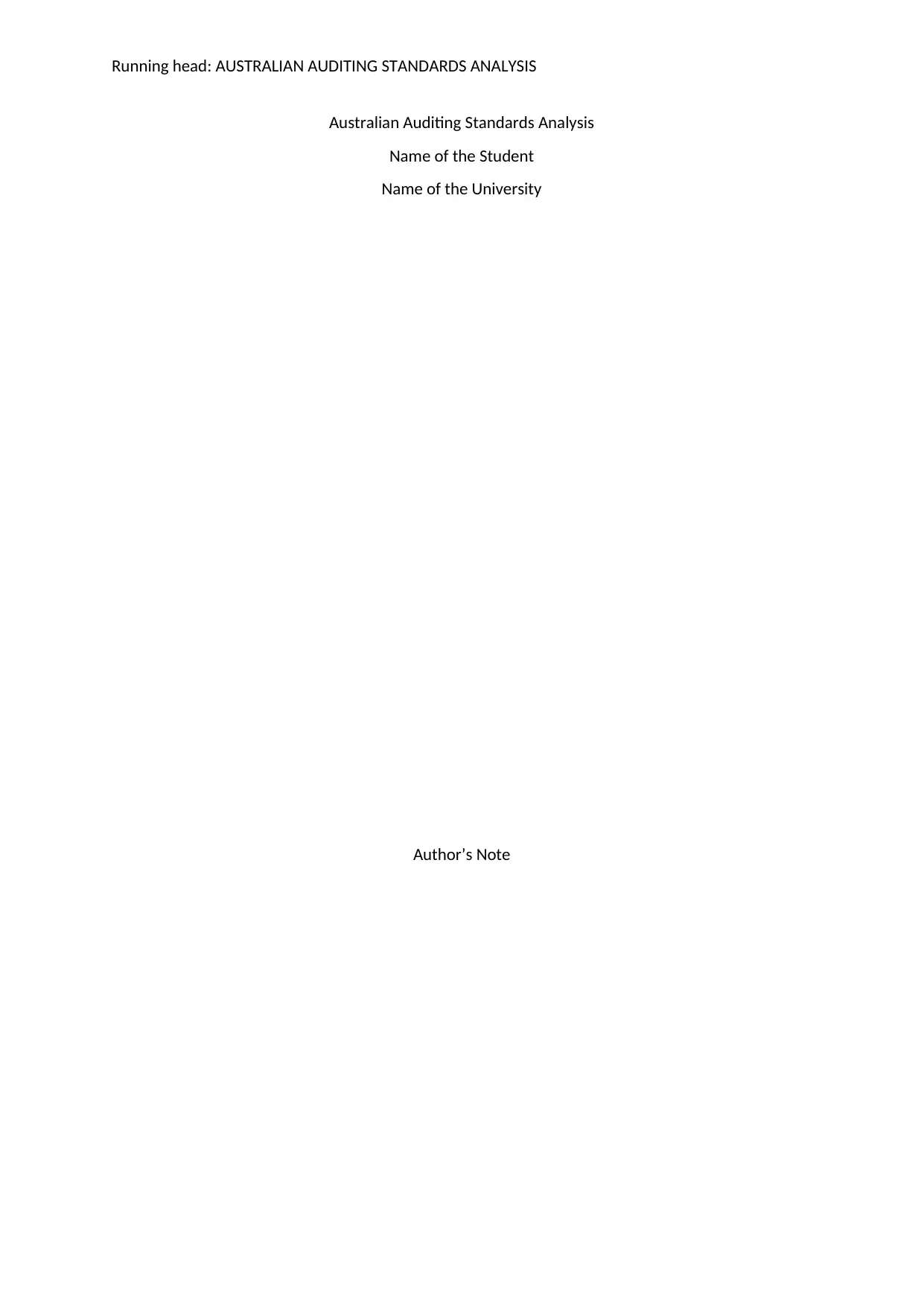
Running head: AUSTRALIAN AUDITING STANDARDS ANALYSIS
Australian Auditing Standards Analysis
Name of the Student
Name of the University
Author’s Note
Australian Auditing Standards Analysis
Name of the Student
Name of the University
Author’s Note
Secure Best Marks with AI Grader
Need help grading? Try our AI Grader for instant feedback on your assignments.
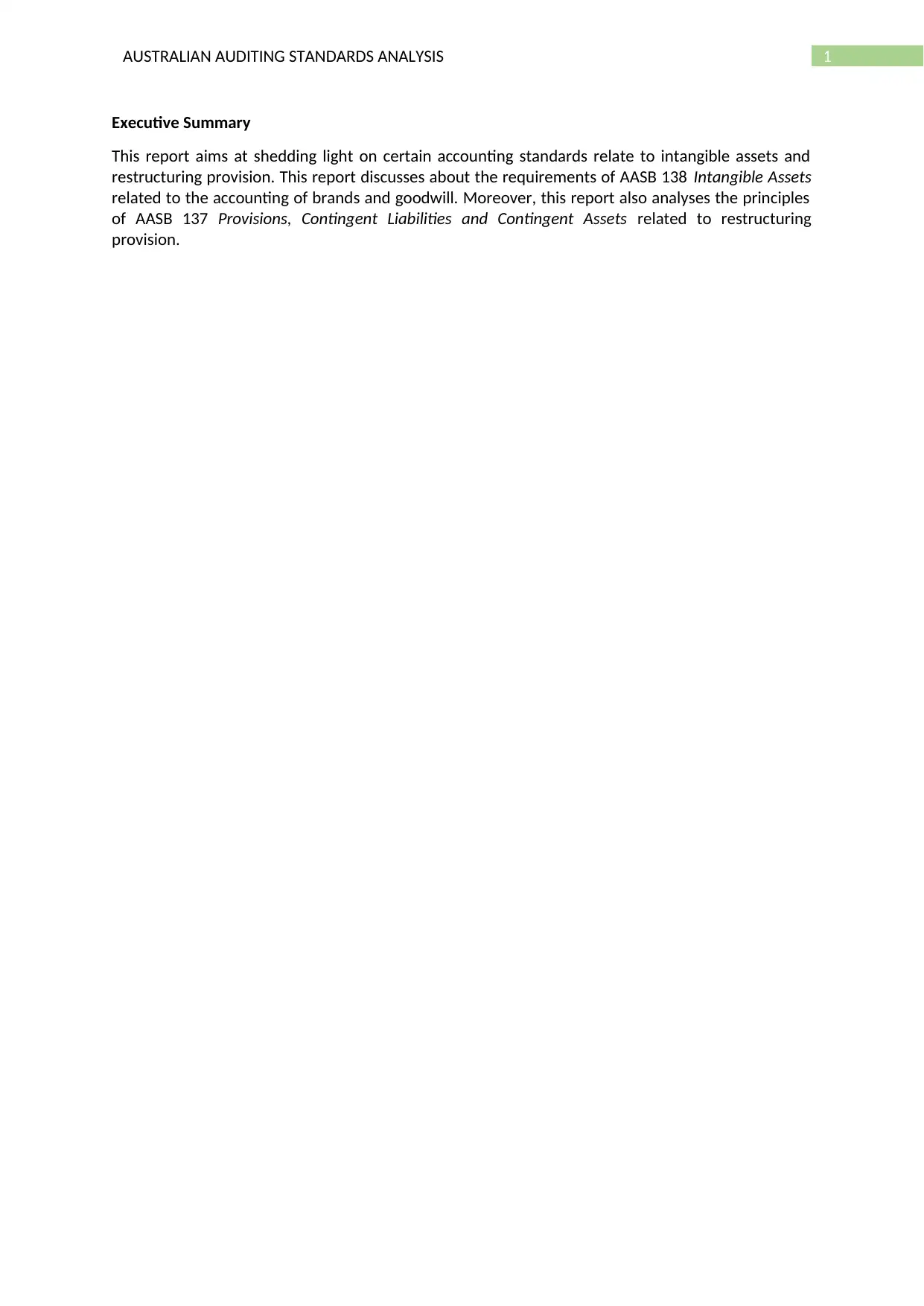
1AUSTRALIAN AUDITING STANDARDS ANALYSIS
Executive Summary
This report aims at shedding light on certain accounting standards relate to intangible assets and
restructuring provision. This report discusses about the requirements of AASB 138 Intangible Assets
related to the accounting of brands and goodwill. Moreover, this report also analyses the principles
of AASB 137 Provisions, Contingent Liabilities and Contingent Assets related to restructuring
provision.
Executive Summary
This report aims at shedding light on certain accounting standards relate to intangible assets and
restructuring provision. This report discusses about the requirements of AASB 138 Intangible Assets
related to the accounting of brands and goodwill. Moreover, this report also analyses the principles
of AASB 137 Provisions, Contingent Liabilities and Contingent Assets related to restructuring
provision.
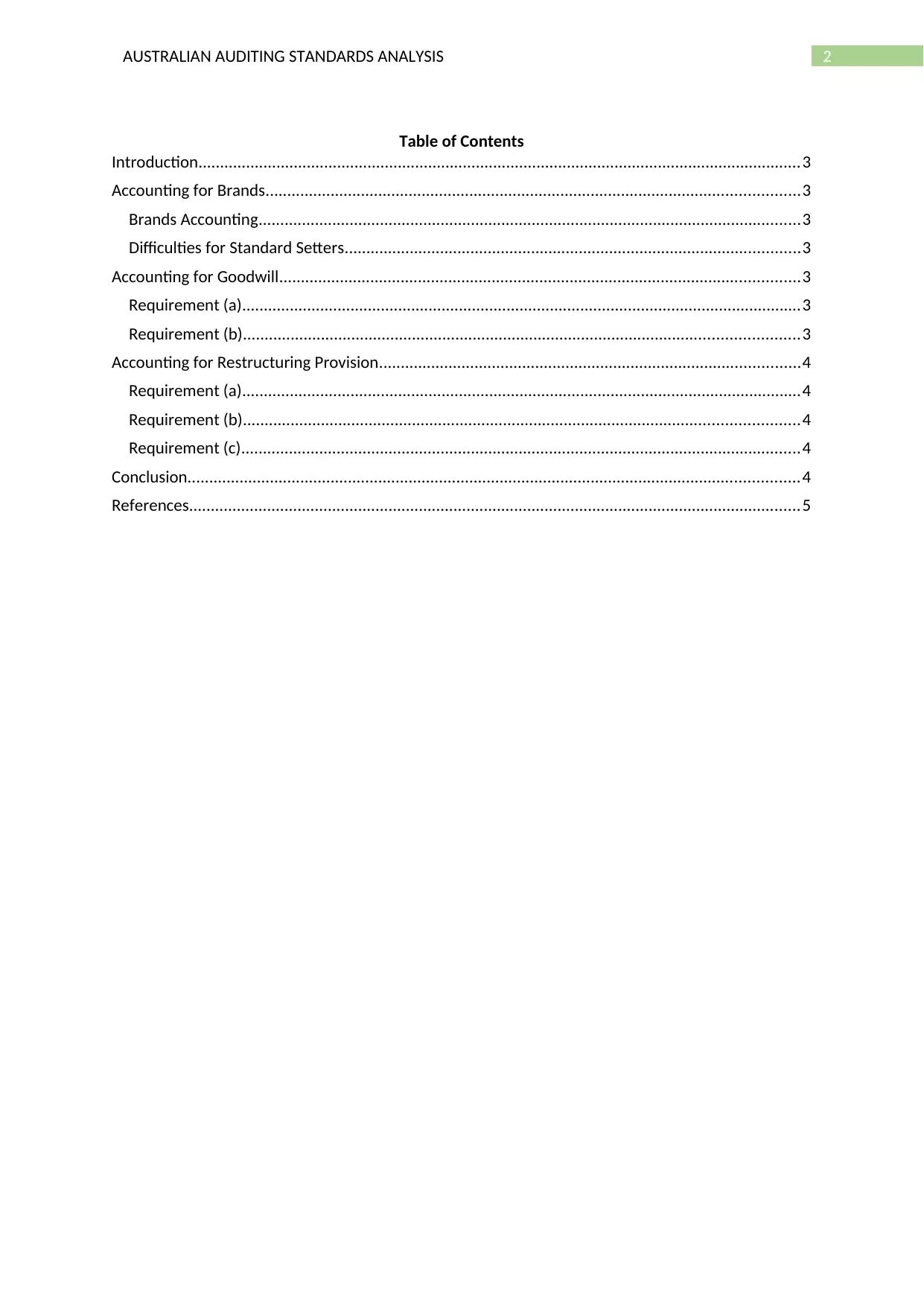
2AUSTRALIAN AUDITING STANDARDS ANALYSIS
Table of Contents
Introduction...........................................................................................................................................3
Accounting for Brands...........................................................................................................................3
Brands Accounting.............................................................................................................................3
Difficulties for Standard Setters.........................................................................................................3
Accounting for Goodwill........................................................................................................................3
Requirement (a).................................................................................................................................3
Requirement (b)................................................................................................................................3
Accounting for Restructuring Provision.................................................................................................4
Requirement (a).................................................................................................................................4
Requirement (b)................................................................................................................................4
Requirement (c).................................................................................................................................4
Conclusion.............................................................................................................................................4
References.............................................................................................................................................5
Table of Contents
Introduction...........................................................................................................................................3
Accounting for Brands...........................................................................................................................3
Brands Accounting.............................................................................................................................3
Difficulties for Standard Setters.........................................................................................................3
Accounting for Goodwill........................................................................................................................3
Requirement (a).................................................................................................................................3
Requirement (b)................................................................................................................................3
Accounting for Restructuring Provision.................................................................................................4
Requirement (a).................................................................................................................................4
Requirement (b)................................................................................................................................4
Requirement (c).................................................................................................................................4
Conclusion.............................................................................................................................................4
References.............................................................................................................................................5
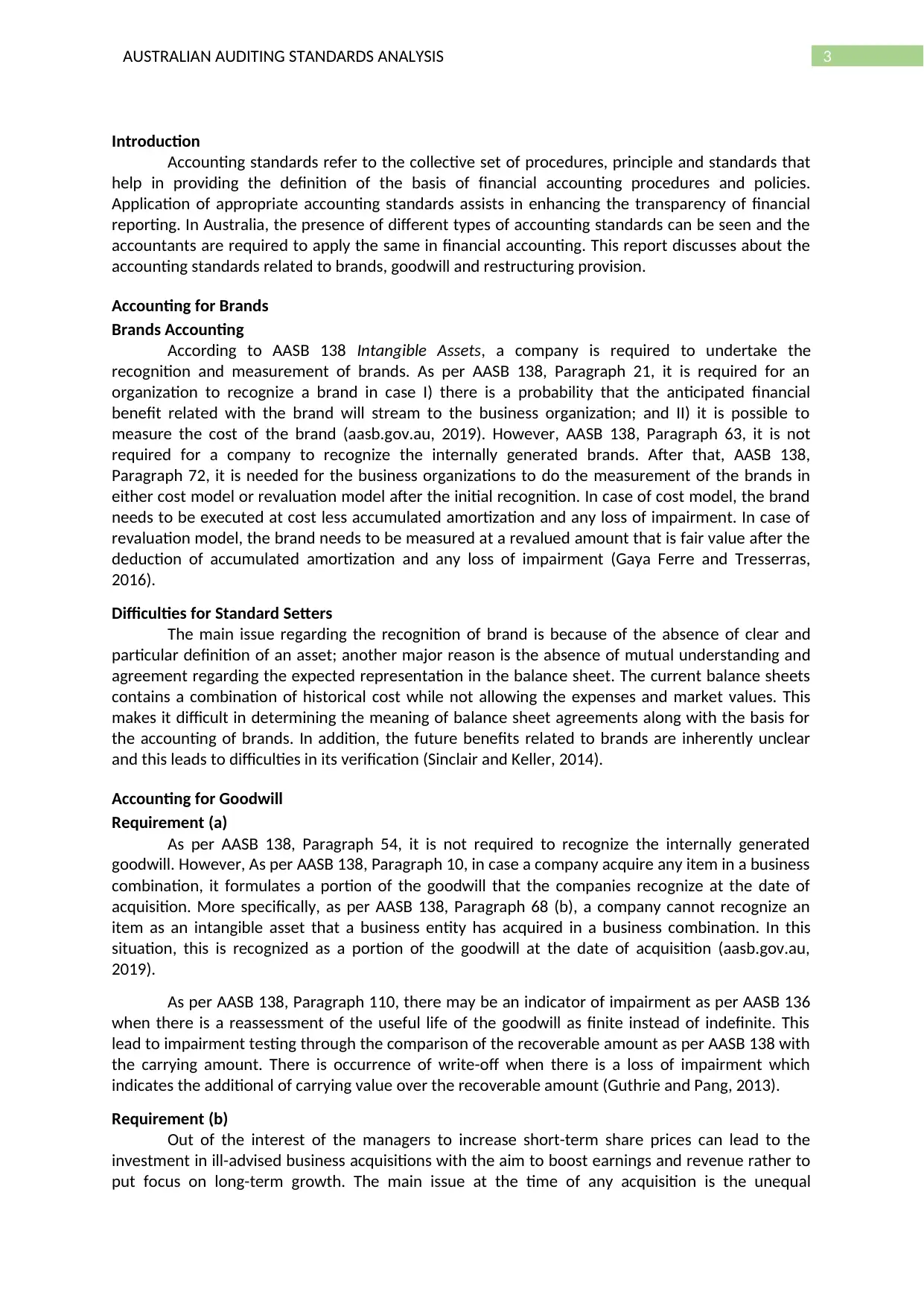
3AUSTRALIAN AUDITING STANDARDS ANALYSIS
Introduction
Accounting standards refer to the collective set of procedures, principle and standards that
help in providing the definition of the basis of financial accounting procedures and policies.
Application of appropriate accounting standards assists in enhancing the transparency of financial
reporting. In Australia, the presence of different types of accounting standards can be seen and the
accountants are required to apply the same in financial accounting. This report discusses about the
accounting standards related to brands, goodwill and restructuring provision.
Accounting for Brands
Brands Accounting
According to AASB 138 Intangible Assets, a company is required to undertake the
recognition and measurement of brands. As per AASB 138, Paragraph 21, it is required for an
organization to recognize a brand in case I) there is a probability that the anticipated financial
benefit related with the brand will stream to the business organization; and II) it is possible to
measure the cost of the brand (aasb.gov.au, 2019). However, AASB 138, Paragraph 63, it is not
required for a company to recognize the internally generated brands. After that, AASB 138,
Paragraph 72, it is needed for the business organizations to do the measurement of the brands in
either cost model or revaluation model after the initial recognition. In case of cost model, the brand
needs to be executed at cost less accumulated amortization and any loss of impairment. In case of
revaluation model, the brand needs to be measured at a revalued amount that is fair value after the
deduction of accumulated amortization and any loss of impairment (Gaya Ferre and Tresserras,
2016).
Difficulties for Standard Setters
The main issue regarding the recognition of brand is because of the absence of clear and
particular definition of an asset; another major reason is the absence of mutual understanding and
agreement regarding the expected representation in the balance sheet. The current balance sheets
contains a combination of historical cost while not allowing the expenses and market values. This
makes it difficult in determining the meaning of balance sheet agreements along with the basis for
the accounting of brands. In addition, the future benefits related to brands are inherently unclear
and this leads to difficulties in its verification (Sinclair and Keller, 2014).
Accounting for Goodwill
Requirement (a)
As per AASB 138, Paragraph 54, it is not required to recognize the internally generated
goodwill. However, As per AASB 138, Paragraph 10, in case a company acquire any item in a business
combination, it formulates a portion of the goodwill that the companies recognize at the date of
acquisition. More specifically, as per AASB 138, Paragraph 68 (b), a company cannot recognize an
item as an intangible asset that a business entity has acquired in a business combination. In this
situation, this is recognized as a portion of the goodwill at the date of acquisition (aasb.gov.au,
2019).
As per AASB 138, Paragraph 110, there may be an indicator of impairment as per AASB 136
when there is a reassessment of the useful life of the goodwill as finite instead of indefinite. This
lead to impairment testing through the comparison of the recoverable amount as per AASB 138 with
the carrying amount. There is occurrence of write-off when there is a loss of impairment which
indicates the additional of carrying value over the recoverable amount (Guthrie and Pang, 2013).
Requirement (b)
Out of the interest of the managers to increase short-term share prices can lead to the
investment in ill-advised business acquisitions with the aim to boost earnings and revenue rather to
put focus on long-term growth. The main issue at the time of any acquisition is the unequal
Introduction
Accounting standards refer to the collective set of procedures, principle and standards that
help in providing the definition of the basis of financial accounting procedures and policies.
Application of appropriate accounting standards assists in enhancing the transparency of financial
reporting. In Australia, the presence of different types of accounting standards can be seen and the
accountants are required to apply the same in financial accounting. This report discusses about the
accounting standards related to brands, goodwill and restructuring provision.
Accounting for Brands
Brands Accounting
According to AASB 138 Intangible Assets, a company is required to undertake the
recognition and measurement of brands. As per AASB 138, Paragraph 21, it is required for an
organization to recognize a brand in case I) there is a probability that the anticipated financial
benefit related with the brand will stream to the business organization; and II) it is possible to
measure the cost of the brand (aasb.gov.au, 2019). However, AASB 138, Paragraph 63, it is not
required for a company to recognize the internally generated brands. After that, AASB 138,
Paragraph 72, it is needed for the business organizations to do the measurement of the brands in
either cost model or revaluation model after the initial recognition. In case of cost model, the brand
needs to be executed at cost less accumulated amortization and any loss of impairment. In case of
revaluation model, the brand needs to be measured at a revalued amount that is fair value after the
deduction of accumulated amortization and any loss of impairment (Gaya Ferre and Tresserras,
2016).
Difficulties for Standard Setters
The main issue regarding the recognition of brand is because of the absence of clear and
particular definition of an asset; another major reason is the absence of mutual understanding and
agreement regarding the expected representation in the balance sheet. The current balance sheets
contains a combination of historical cost while not allowing the expenses and market values. This
makes it difficult in determining the meaning of balance sheet agreements along with the basis for
the accounting of brands. In addition, the future benefits related to brands are inherently unclear
and this leads to difficulties in its verification (Sinclair and Keller, 2014).
Accounting for Goodwill
Requirement (a)
As per AASB 138, Paragraph 54, it is not required to recognize the internally generated
goodwill. However, As per AASB 138, Paragraph 10, in case a company acquire any item in a business
combination, it formulates a portion of the goodwill that the companies recognize at the date of
acquisition. More specifically, as per AASB 138, Paragraph 68 (b), a company cannot recognize an
item as an intangible asset that a business entity has acquired in a business combination. In this
situation, this is recognized as a portion of the goodwill at the date of acquisition (aasb.gov.au,
2019).
As per AASB 138, Paragraph 110, there may be an indicator of impairment as per AASB 136
when there is a reassessment of the useful life of the goodwill as finite instead of indefinite. This
lead to impairment testing through the comparison of the recoverable amount as per AASB 138 with
the carrying amount. There is occurrence of write-off when there is a loss of impairment which
indicates the additional of carrying value over the recoverable amount (Guthrie and Pang, 2013).
Requirement (b)
Out of the interest of the managers to increase short-term share prices can lead to the
investment in ill-advised business acquisitions with the aim to boost earnings and revenue rather to
put focus on long-term growth. The main issue at the time of any acquisition is the unequal
Secure Best Marks with AI Grader
Need help grading? Try our AI Grader for instant feedback on your assignments.
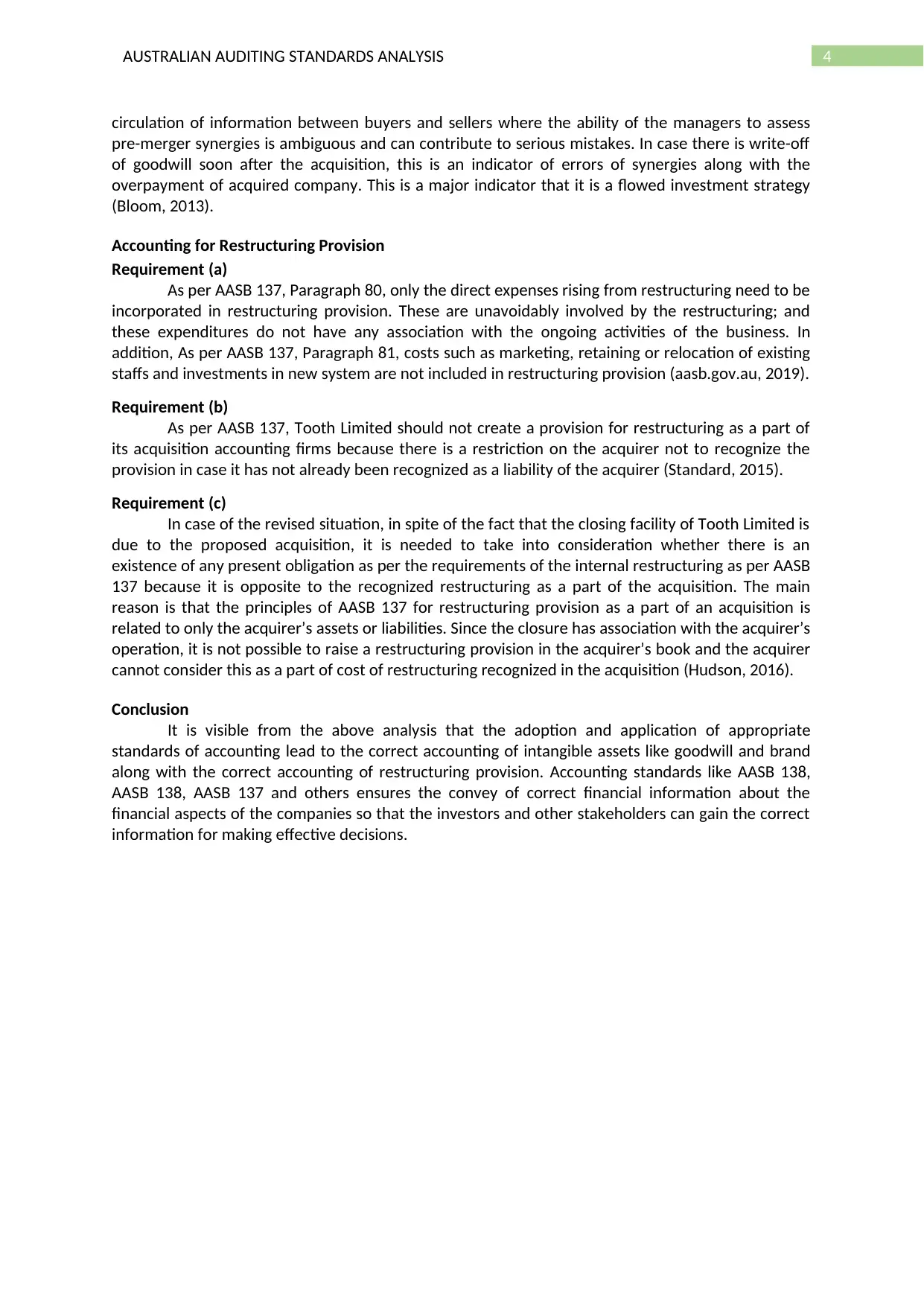
4AUSTRALIAN AUDITING STANDARDS ANALYSIS
circulation of information between buyers and sellers where the ability of the managers to assess
pre-merger synergies is ambiguous and can contribute to serious mistakes. In case there is write-off
of goodwill soon after the acquisition, this is an indicator of errors of synergies along with the
overpayment of acquired company. This is a major indicator that it is a flowed investment strategy
(Bloom, 2013).
Accounting for Restructuring Provision
Requirement (a)
As per AASB 137, Paragraph 80, only the direct expenses rising from restructuring need to be
incorporated in restructuring provision. These are unavoidably involved by the restructuring; and
these expenditures do not have any association with the ongoing activities of the business. In
addition, As per AASB 137, Paragraph 81, costs such as marketing, retaining or relocation of existing
staffs and investments in new system are not included in restructuring provision (aasb.gov.au, 2019).
Requirement (b)
As per AASB 137, Tooth Limited should not create a provision for restructuring as a part of
its acquisition accounting firms because there is a restriction on the acquirer not to recognize the
provision in case it has not already been recognized as a liability of the acquirer (Standard, 2015).
Requirement (c)
In case of the revised situation, in spite of the fact that the closing facility of Tooth Limited is
due to the proposed acquisition, it is needed to take into consideration whether there is an
existence of any present obligation as per the requirements of the internal restructuring as per AASB
137 because it is opposite to the recognized restructuring as a part of the acquisition. The main
reason is that the principles of AASB 137 for restructuring provision as a part of an acquisition is
related to only the acquirer’s assets or liabilities. Since the closure has association with the acquirer’s
operation, it is not possible to raise a restructuring provision in the acquirer’s book and the acquirer
cannot consider this as a part of cost of restructuring recognized in the acquisition (Hudson, 2016).
Conclusion
It is visible from the above analysis that the adoption and application of appropriate
standards of accounting lead to the correct accounting of intangible assets like goodwill and brand
along with the correct accounting of restructuring provision. Accounting standards like AASB 138,
AASB 138, AASB 137 and others ensures the convey of correct financial information about the
financial aspects of the companies so that the investors and other stakeholders can gain the correct
information for making effective decisions.
circulation of information between buyers and sellers where the ability of the managers to assess
pre-merger synergies is ambiguous and can contribute to serious mistakes. In case there is write-off
of goodwill soon after the acquisition, this is an indicator of errors of synergies along with the
overpayment of acquired company. This is a major indicator that it is a flowed investment strategy
(Bloom, 2013).
Accounting for Restructuring Provision
Requirement (a)
As per AASB 137, Paragraph 80, only the direct expenses rising from restructuring need to be
incorporated in restructuring provision. These are unavoidably involved by the restructuring; and
these expenditures do not have any association with the ongoing activities of the business. In
addition, As per AASB 137, Paragraph 81, costs such as marketing, retaining or relocation of existing
staffs and investments in new system are not included in restructuring provision (aasb.gov.au, 2019).
Requirement (b)
As per AASB 137, Tooth Limited should not create a provision for restructuring as a part of
its acquisition accounting firms because there is a restriction on the acquirer not to recognize the
provision in case it has not already been recognized as a liability of the acquirer (Standard, 2015).
Requirement (c)
In case of the revised situation, in spite of the fact that the closing facility of Tooth Limited is
due to the proposed acquisition, it is needed to take into consideration whether there is an
existence of any present obligation as per the requirements of the internal restructuring as per AASB
137 because it is opposite to the recognized restructuring as a part of the acquisition. The main
reason is that the principles of AASB 137 for restructuring provision as a part of an acquisition is
related to only the acquirer’s assets or liabilities. Since the closure has association with the acquirer’s
operation, it is not possible to raise a restructuring provision in the acquirer’s book and the acquirer
cannot consider this as a part of cost of restructuring recognized in the acquisition (Hudson, 2016).
Conclusion
It is visible from the above analysis that the adoption and application of appropriate
standards of accounting lead to the correct accounting of intangible assets like goodwill and brand
along with the correct accounting of restructuring provision. Accounting standards like AASB 138,
AASB 138, AASB 137 and others ensures the convey of correct financial information about the
financial aspects of the companies so that the investors and other stakeholders can gain the correct
information for making effective decisions.
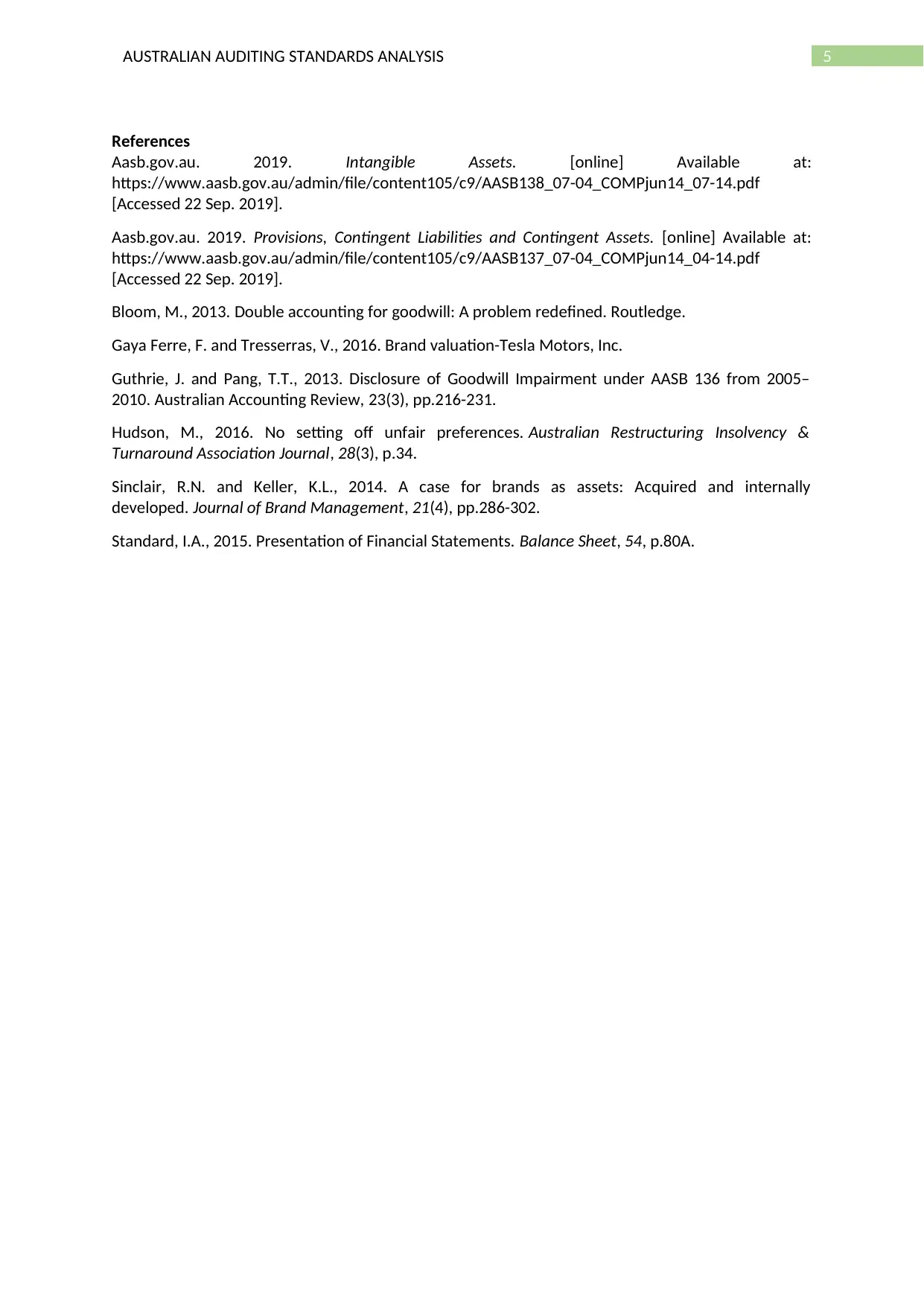
5AUSTRALIAN AUDITING STANDARDS ANALYSIS
References
Aasb.gov.au. 2019. Intangible Assets. [online] Available at:
https://www.aasb.gov.au/admin/file/content105/c9/AASB138_07-04_COMPjun14_07-14.pdf
[Accessed 22 Sep. 2019].
Aasb.gov.au. 2019. Provisions, Contingent Liabilities and Contingent Assets. [online] Available at:
https://www.aasb.gov.au/admin/file/content105/c9/AASB137_07-04_COMPjun14_04-14.pdf
[Accessed 22 Sep. 2019].
Bloom, M., 2013. Double accounting for goodwill: A problem redefined. Routledge.
Gaya Ferre, F. and Tresserras, V., 2016. Brand valuation-Tesla Motors, Inc.
Guthrie, J. and Pang, T.T., 2013. Disclosure of Goodwill Impairment under AASB 136 from 2005–
2010. Australian Accounting Review, 23(3), pp.216-231.
Hudson, M., 2016. No setting off unfair preferences. Australian Restructuring Insolvency &
Turnaround Association Journal, 28(3), p.34.
Sinclair, R.N. and Keller, K.L., 2014. A case for brands as assets: Acquired and internally
developed. Journal of Brand Management, 21(4), pp.286-302.
Standard, I.A., 2015. Presentation of Financial Statements. Balance Sheet, 54, p.80A.
References
Aasb.gov.au. 2019. Intangible Assets. [online] Available at:
https://www.aasb.gov.au/admin/file/content105/c9/AASB138_07-04_COMPjun14_07-14.pdf
[Accessed 22 Sep. 2019].
Aasb.gov.au. 2019. Provisions, Contingent Liabilities and Contingent Assets. [online] Available at:
https://www.aasb.gov.au/admin/file/content105/c9/AASB137_07-04_COMPjun14_04-14.pdf
[Accessed 22 Sep. 2019].
Bloom, M., 2013. Double accounting for goodwill: A problem redefined. Routledge.
Gaya Ferre, F. and Tresserras, V., 2016. Brand valuation-Tesla Motors, Inc.
Guthrie, J. and Pang, T.T., 2013. Disclosure of Goodwill Impairment under AASB 136 from 2005–
2010. Australian Accounting Review, 23(3), pp.216-231.
Hudson, M., 2016. No setting off unfair preferences. Australian Restructuring Insolvency &
Turnaround Association Journal, 28(3), p.34.
Sinclair, R.N. and Keller, K.L., 2014. A case for brands as assets: Acquired and internally
developed. Journal of Brand Management, 21(4), pp.286-302.
Standard, I.A., 2015. Presentation of Financial Statements. Balance Sheet, 54, p.80A.
1 out of 6
Related Documents
Your All-in-One AI-Powered Toolkit for Academic Success.
+13062052269
info@desklib.com
Available 24*7 on WhatsApp / Email
![[object Object]](/_next/static/media/star-bottom.7253800d.svg)
Unlock your academic potential
© 2024 | Zucol Services PVT LTD | All rights reserved.




